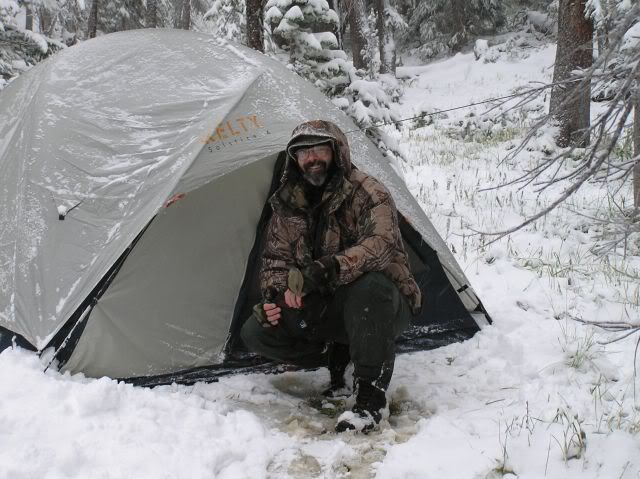Post by BT on Nov 12, 2006 8:17:13 GMT -5
Alot of people do very well with the longbow but others fail to ever get it because (I believe) they don't understand the method of aiming. 
It's like throwing a baseball....some people can throw strikes consistently until their arm wears out while others couldn't throw a strike to save their life.
It isn't how fast you throw the ball that matters but rather where you throw the ball and that is what I am going to try to explain here.
(hopefully with an assist from my trad. moderators)
A Baseball is a good comparison to the arrow (in as much as) with the ball you become the bow which is no more than a launching mechanism like the bow.
It is the eye and mind that determine where the ball is going to go when it leaves the hand.
The fact that you don't sight the ball is not to say that the ball is not aimed.
Indeed it is aimed but in an almost subconscious level with the eye acting as a corrective part of the launching device ...namely the arm.
The fast ball does not go straight to the catchers glove since it is to heavy and so it falls and also cuts at an angle inward as it leaves the hand which is off center of the body that aligns itself with the catchers mitt.
Here is where the eye corrects for the drop and cut by shifting the ball to leave the hand high and to one side so that it ends up at point B on line with point A.
The same thing is done with the arrow or that is to say that it should be done but for some reason people want to cast that arrow like a laser , which cannot be done.
I think this is because the arrow is visible in the line of sight and therefore the person wants to point it at what is perceived to be at the target.
I reality pointing at the target will have a negative effect unless you are anchoring directly under the eye and then the arrow will still be off line of sight and will impact high while on its flat path trajectory.
for the right handed shooter the arrow will impact left and visa/versa for the lefty.
This is because the anchor is held to the side of the eye,against the head , causing the arrow to angle through the line of sight.
Depending on the anchoring position it will generally hit low with a three under or high on a one over hand position on the string.
I always recommend the three under because it gets the arrow closest to the eye and makes the margin of error less and therefore the gap easier to compensate for.
Here are some visual examples.
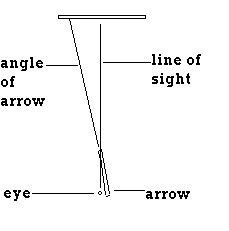
Here is the example of how the arrow travels through the line of sight and why most people cannot shoot traditional.
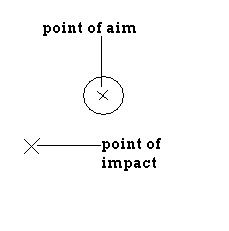
Here is what happens when the right handed archer (shooting three under) attempts to hold spot on.
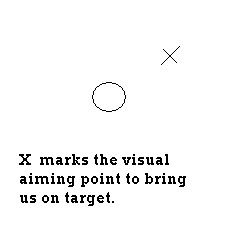
Here is where he should be aiming
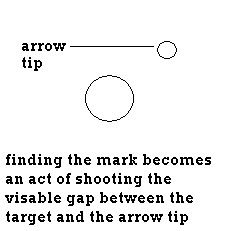
Here is what the sight picture should look like
----------------------------------------------------------------------------------
For myself , when shooting the longbow , my sight picture looks like I am laying the bottom of the arrow on top of the target at 1:00.
This will be different for everyone as their anchors will be different.
Some will indeed be the same but many more will be different to some extent.
This is referred to as instinctive shooting and not gap shooting.
Gap shooting refers to distance....just in case anyone wants to know.
True instinctive shooting comes from knowing where to release and you are not aware of it....you just do it.
Some people can do it from day one.
Generally children are super good and as the age progresses the ability regresses
Probably due to no more than a persons willingness/desire to over think the situation handed them
After a period of time you will no longer require an actual physical check of the arrows position and the brain will take the wheel , acting as a check as you come to full draw and just before you release.
It is good to attempt to shoot without checking the arrows position once you have come to the point of where you are consistent.
To rely too heavily on this method can ruin you as the computer (called the brain) attempts to take a decimal to the 1000th place so to speak
If (after a day or a couple of hours) you find that it just isn't working , go back to your standard shooting style and try it again in a week or two....or mix it up as you shoot with the occasional volley of blind shots.
This is done by focusing on the spot to be hit to the point of tunnel vision and some people just cannot do it
If you are one of those people then don't beat yourself up by trying it...you'll just get upset and frustrated.
Instead , stay with what works
When getting to the point of letting the brain take over I highly recommend stump shooting in the off season.
targets at unknown distances and sizes will feed far better information to the brain and shorten the learning curve dramatically.
Targets such as a pine cone or leaf at ranges up to 40 - 50 yards or more will be the best source of education as range estimation is a act of learning cast and you will be able to get a much better read on your line of sight as these longer shots will magnify any errors.
Within 4-6 months you should be hitting pine cones at 40 yards with an occasional miss only.
This is no joke
If you put in the time and the time with correct practice
you could become the next Byron Ferguson.
(AT LEAST AMONG YOUR FRIENDS
 )
)

It's like throwing a baseball....some people can throw strikes consistently until their arm wears out while others couldn't throw a strike to save their life.

It isn't how fast you throw the ball that matters but rather where you throw the ball and that is what I am going to try to explain here.

(hopefully with an assist from my trad. moderators)
A Baseball is a good comparison to the arrow (in as much as) with the ball you become the bow which is no more than a launching mechanism like the bow.
It is the eye and mind that determine where the ball is going to go when it leaves the hand.
The fact that you don't sight the ball is not to say that the ball is not aimed.
Indeed it is aimed but in an almost subconscious level with the eye acting as a corrective part of the launching device ...namely the arm.
The fast ball does not go straight to the catchers glove since it is to heavy and so it falls and also cuts at an angle inward as it leaves the hand which is off center of the body that aligns itself with the catchers mitt.
Here is where the eye corrects for the drop and cut by shifting the ball to leave the hand high and to one side so that it ends up at point B on line with point A.
The same thing is done with the arrow or that is to say that it should be done but for some reason people want to cast that arrow like a laser , which cannot be done.

I think this is because the arrow is visible in the line of sight and therefore the person wants to point it at what is perceived to be at the target.
I reality pointing at the target will have a negative effect unless you are anchoring directly under the eye and then the arrow will still be off line of sight and will impact high while on its flat path trajectory.
for the right handed shooter the arrow will impact left and visa/versa for the lefty.
This is because the anchor is held to the side of the eye,against the head , causing the arrow to angle through the line of sight.
Depending on the anchoring position it will generally hit low with a three under or high on a one over hand position on the string.
I always recommend the three under because it gets the arrow closest to the eye and makes the margin of error less and therefore the gap easier to compensate for.
Here are some visual examples.

Here is the example of how the arrow travels through the line of sight and why most people cannot shoot traditional.


Here is what happens when the right handed archer (shooting three under) attempts to hold spot on.

Here is where he should be aiming

Here is what the sight picture should look like
----------------------------------------------------------------------------------
For myself , when shooting the longbow , my sight picture looks like I am laying the bottom of the arrow on top of the target at 1:00.
This will be different for everyone as their anchors will be different.
Some will indeed be the same but many more will be different to some extent.
This is referred to as instinctive shooting and not gap shooting.
Gap shooting refers to distance....just in case anyone wants to know.
True instinctive shooting comes from knowing where to release and you are not aware of it....you just do it.
Some people can do it from day one.
Generally children are super good and as the age progresses the ability regresses

Probably due to no more than a persons willingness/desire to over think the situation handed them

After a period of time you will no longer require an actual physical check of the arrows position and the brain will take the wheel , acting as a check as you come to full draw and just before you release.
It is good to attempt to shoot without checking the arrows position once you have come to the point of where you are consistent.
To rely too heavily on this method can ruin you as the computer (called the brain) attempts to take a decimal to the 1000th place so to speak

If (after a day or a couple of hours) you find that it just isn't working , go back to your standard shooting style and try it again in a week or two....or mix it up as you shoot with the occasional volley of blind shots.
This is done by focusing on the spot to be hit to the point of tunnel vision and some people just cannot do it

If you are one of those people then don't beat yourself up by trying it...you'll just get upset and frustrated.
Instead , stay with what works

When getting to the point of letting the brain take over I highly recommend stump shooting in the off season.
targets at unknown distances and sizes will feed far better information to the brain and shorten the learning curve dramatically.
Targets such as a pine cone or leaf at ranges up to 40 - 50 yards or more will be the best source of education as range estimation is a act of learning cast and you will be able to get a much better read on your line of sight as these longer shots will magnify any errors.
Within 4-6 months you should be hitting pine cones at 40 yards with an occasional miss only.
This is no joke

If you put in the time and the time with correct practice
you could become the next Byron Ferguson.
(AT LEAST AMONG YOUR FRIENDS

 )
)

 )! The pressing will teach you muscle memory too, so your anchor spot will come more naturally over time. AIM...NOW is the moment you sight the arrow left/right and up/down. You'll find you have a spot at which you can aim dead on and the arrow goes right in...THAT is your sweet spot....mine is exactly at 20 yards(How convenient
)! The pressing will teach you muscle memory too, so your anchor spot will come more naturally over time. AIM...NOW is the moment you sight the arrow left/right and up/down. You'll find you have a spot at which you can aim dead on and the arrow goes right in...THAT is your sweet spot....mine is exactly at 20 yards(How convenient  ). Now you suimply allow your fingers to relax on the draw hand, while continuing to look at where your arrow is going to go. A personal note---with all the injuries, and physical problems, along with shooting VANES off of a flipper rest on a recurve, I am shooting honest one inch groups consistently at 20 yards, and four inches at 30. Tjhis is after just two months. So, may DAPAR be upon you, and follow BT's advice!!!
). Now you suimply allow your fingers to relax on the draw hand, while continuing to look at where your arrow is going to go. A personal note---with all the injuries, and physical problems, along with shooting VANES off of a flipper rest on a recurve, I am shooting honest one inch groups consistently at 20 yards, and four inches at 30. Tjhis is after just two months. So, may DAPAR be upon you, and follow BT's advice!!! 
